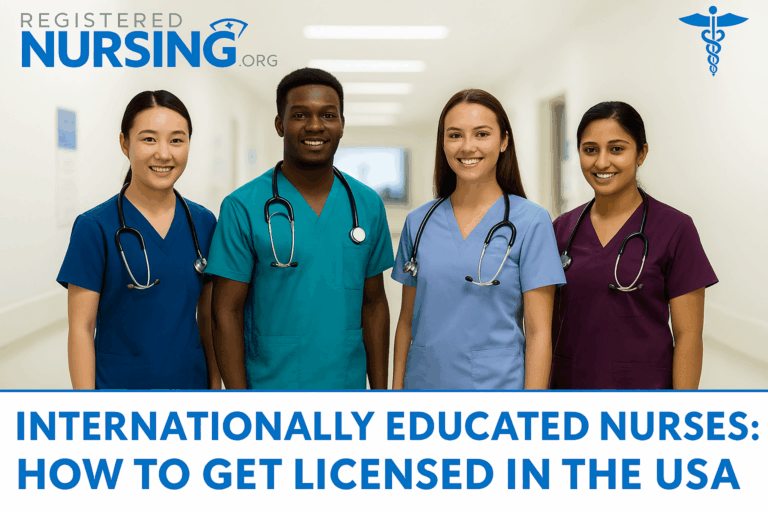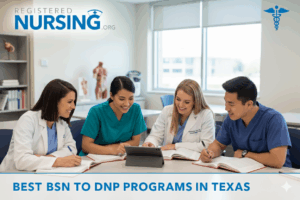Internationally Educated Nurses: How to Get Licensed to Practice in the U.S.

Internationally educated nurses (IENs) are a vital part of the U.S. healthcare system. With growing nursing shortages and increasing demand for experienced clinicians, many U.S. states actively welcome qualified foreign-trained nurses. However, the U.S. licensure process can be complex, involving credential evaluation, language testing, immigration requirements, and passing the NCLEX-RN.
This comprehensive guide breaks down each step so you can move forward with confidence.
This article will cover:
- Step-by-step U.S. RN licensure requirements for internationally educated nurses
- Credential evaluation, English proficiency testing, and NCLEX rules
- Visa requirements and employment pathways
- State-specific variations in the licensure process
- Educational options for international students who want to advance their nursing careers in the U.S.
Understanding How U.S. Nursing Licensure Works
The United States does not have a single national nursing license. Instead:
- Each state has its own Board of Nursing (BON).
- You must meet that state's education, exam, and immigration requirements.
- All RNs must pass the NCLEX-RN, regardless of where they were educated.
Most states follow similar steps, but requirements vary, so always check the board's website for the most current regulations.
Step 1: Choose the State Where You Want to Practice
Licensing requirements differ by state. Some states are known for smoother IEN processing, while others require additional coursework or clinical verification.
Examples of State-Specific Differences:
- New York: Allows IENs to take the NCLEX without a U.S. SSN.
- California: Requires strict concurrency between nursing theory and clinical practice.
- Texas & Florida: Common destinations for IENs with established evaluation systems.
- Nurse Licensure Compact States: RNs licensed in NLC states may qualify for multi-state privileges (once citizenship/permanent residency is obtained).
Learn more about nursing schools in your state.
Step 2: Undergo Credential Evaluation
All internationally educated nurses must have their nursing education evaluated by an approved credentialing agency. The three most commonly accepted evaluators include:
Credentialing Agencies:
- CGFNS (Commission on Graduates of Foreign Nursing Schools)
- ICES (International Credential Evaluation Services) – accepted by some state boards
- ECE (Educational Credential Evaluators)
What Credential Evaluation Includes:
- Verification of nursing education
- Validation of clinical and theory hours
- Confirmation of RN licensure from home country
- Transcript review and translation if needed
Typical Documents Required:
- Official nursing school transcripts
- Verification of foreign nursing license
- Proof of identity
- Secondary school diploma (varies by state)
Step 3: Demonstrate English Language Proficiency
IENs must typically pass an English exam unless educated in an exempt country (such as Canada outside Quebec, the UK, Australia, or New Zealand).
Accepted English Exams
| Exam | Typical Passing Score |
| TOEFL iBT | ~83–90 overall (varies by state) |
| IELTS Academic | Overall 6.5–7.0 |
| PTE Academic | ~55–60 |
| OET Nursing | Minimum grade B in all areas |
Tip: Exemptions differ by state, so verify before registering for an exam.
Step 4: Apply to the State Board of Nursing
Once your credentials are submitted, you can apply for RN licensure with the state board.
Common Requirements:
- Background check / fingerprinting
- Application fee
- Credential report submission
- Passing English exam results
- Authorization to Test (ATT) request
Each state will review your file and determine eligibility to take the NCLEX-RN.
Step 5: Pass the NCLEX-RN
Every foreign-trained nurse must pass the NCLEX-RN, the national licensure exam for registered nurses in the U.S.
NCLEX Exam Includes:
- Clinical judgment (Next Generation NCLEX format)
- Pharmacology
- Safety & infection control
- Patient care management
- Psychosocial and physiological adaptation
Preparing thoroughly is essential, especially since some IENs have been out of school for several years.
Step 6: Secure the Appropriate Visa
Immigration requirements vary depending on your pathway to the U.S.
Common Visa Options for IENs
1. Employment-Based Visa (EB-3)
- Most common path for foreign nurses.
- Requires a U.S. employer sponsor.
- Nurses qualify under the "Schedule A" shortage category.
2. TN Visa (Canadian & Mexican Nurses Only)
- Allows registered nurses from Canada and Mexico to work temporarily in the U.S.
3. H-1B (Rare for Nurses)
- Usually for specialized nursing roles requiring advanced degrees.
4. Student Visa (F-1)
- For IENs enrolling in programs such as BSN, MSN, or DNP.
Step 7: Obtain U.S. RN Licensure
After passing the NCLEX and meeting all requirements, you will receive your RN license from the state board.
You may then:
- Apply for employment
- Begin orientation or residency programs
- Pursue additional certifications (e.g., BLS, ACLS, specialty certs)
Summary: Typical Licensure Pathway for IENs
| Step | Description |
| 1 | Choose a state board of nursing |
| 2 | Complete credential evaluation |
| 3 | Take English exam (if required) |
| 4 | Apply for RN licensure |
| 5 | Receive ATT and pass NCLEX-RN |
| 6 | Apply for employment-based visa |
| 7 | Receive RN license and practice |
Educational Options for International Nurses in the U.S.
Many IENs pursue higher education once in the U.S. to expand their opportunities.
1. RN to BSN Programs
IENs with an RN license from their home country may enroll in RN to BSN programs after passing NCLEX-RN.
Benefits:
- Short duration (9–18 months)
- Fully online options
- Increased employability
- Leadership and public health coursework
2. Master of Science in Nursing (MSN)
IENs aiming for advanced practice, education, or leadership roles can pursue an MSN degree after becoming a licensed U.S. RN.
Common MSN Tracks:
- Nurse Practitioner (FNP, AGNP, PMHNP, etc.)
- Nurse Educator
- Clinical Nurse Specialist (CNS)
3. Doctor of Nursing Practice (DNP)
For advanced clinical or organizational leadership roles, the DNP degree offers the highest level of practice-based education.
4. Professional Bridge Programs for IENs
Some universities and hospitals offer Internationally Educated Nurse bridge programs, designed to:
- Refresh clinical skills
- Prepare for NCLEX
- Improve English proficiency
- Transition IENs into U.S. healthcare culture
Examples may include hospital-based transition programs or university skills-bridging coursework.
Common Challenges International Nurses Face
- Credential inconsistencies: Some foreign programs lack required clinical hour structure.
- Delayed document processing: Transcripts and credentialing verification can take months.
- Visa wait times: Employment visas may take significant processing time.
- Cultural & practice differences: U.S. healthcare emphasizes patient autonomy, documentation systems, and interdisciplinary communication.
Tip: Many IENs benefit from U.S.-based NCLEX prep courses and clinical transition programs designed specifically for internationally trained nurses.
FAQs
Q: Can I take the NCLEX-RN without a Social Security Number?
A: In some states, such as New York, you can. Others require an SSN before issuing a license. Check the state board's requirements.
Q: Are internationally educated nurses eligible for the Nurse Licensure Compact (NLC)?
A: Only once they become permanent residents or U.S. citizens and meet the state's requirements. Temporary visa holders are not eligible.
Q: Do I need U.S. clinical experience before working?
A: Not usually, but many employers require orientation or residency programs. Some states mandate clinical verification during credential review.
Q: Can an international nurse work as an LPN/LVN/L first?
A: Possibly. Some IENs pursue LPN/LVN licensure while completing RN requirements, but this depends on state rules and education equivalency.
Q: How long does the entire licensing process take?
A: Anywhere from 6 months to 2+ years, depending on credential evaluation, visa processing, and exam preparation.
Latest Articles & Guides
One of the keys to success as a registered nurse is embracing lifelong learning. Our articles and guides address hot topics and current events in nursing, from education to career mobility and beyond. No matter where you are on your nursing journey, there’s an article to help you build your knowledge base.
Browse our latest articles, curated specifically for modern nurses.



